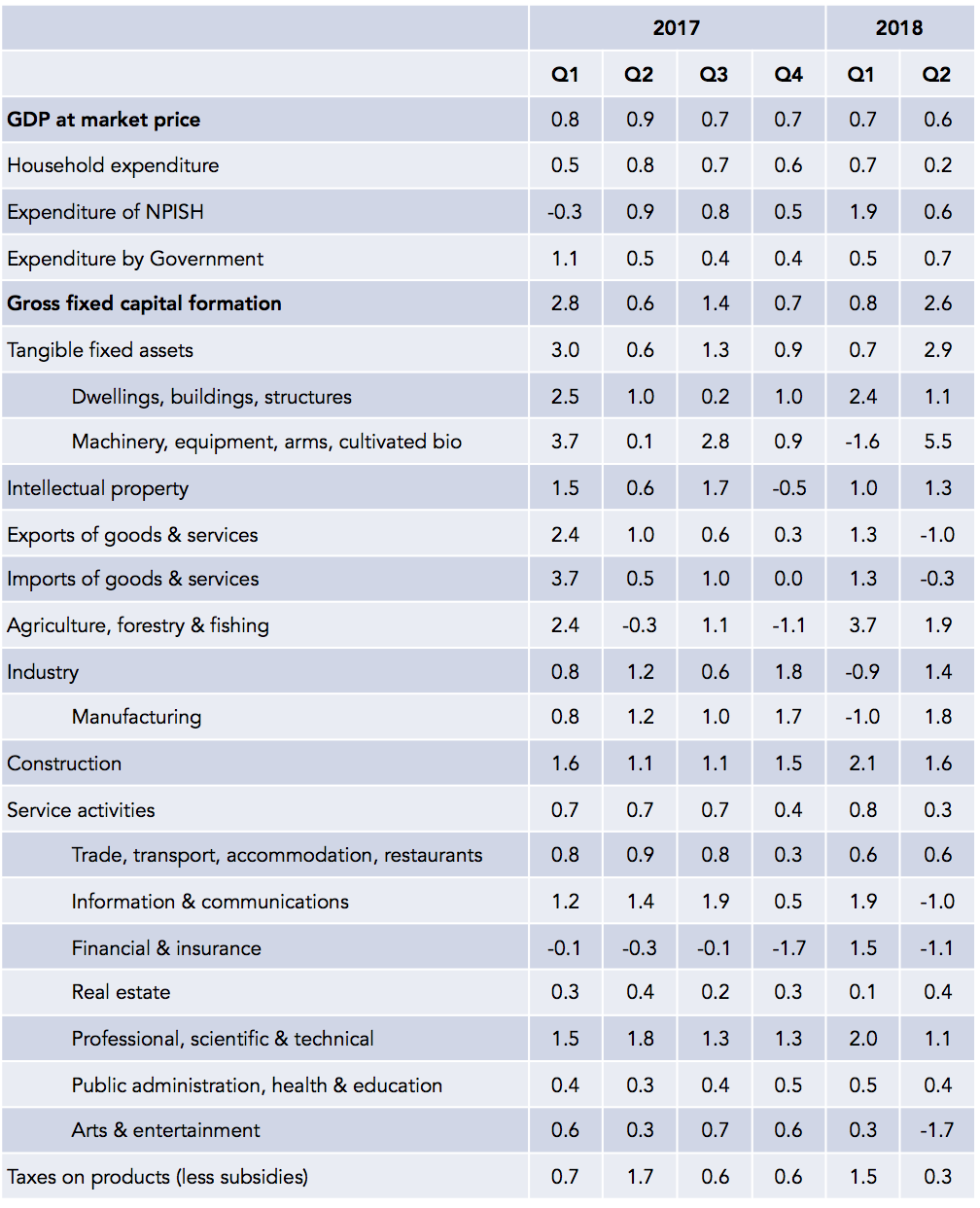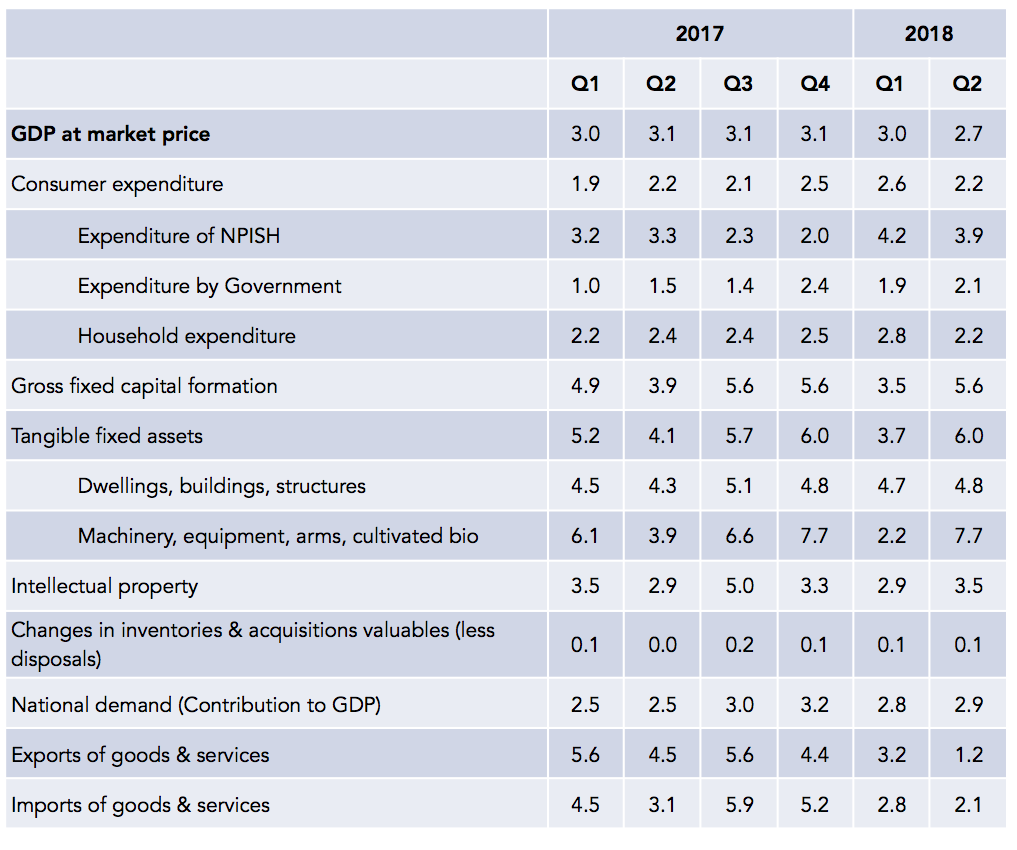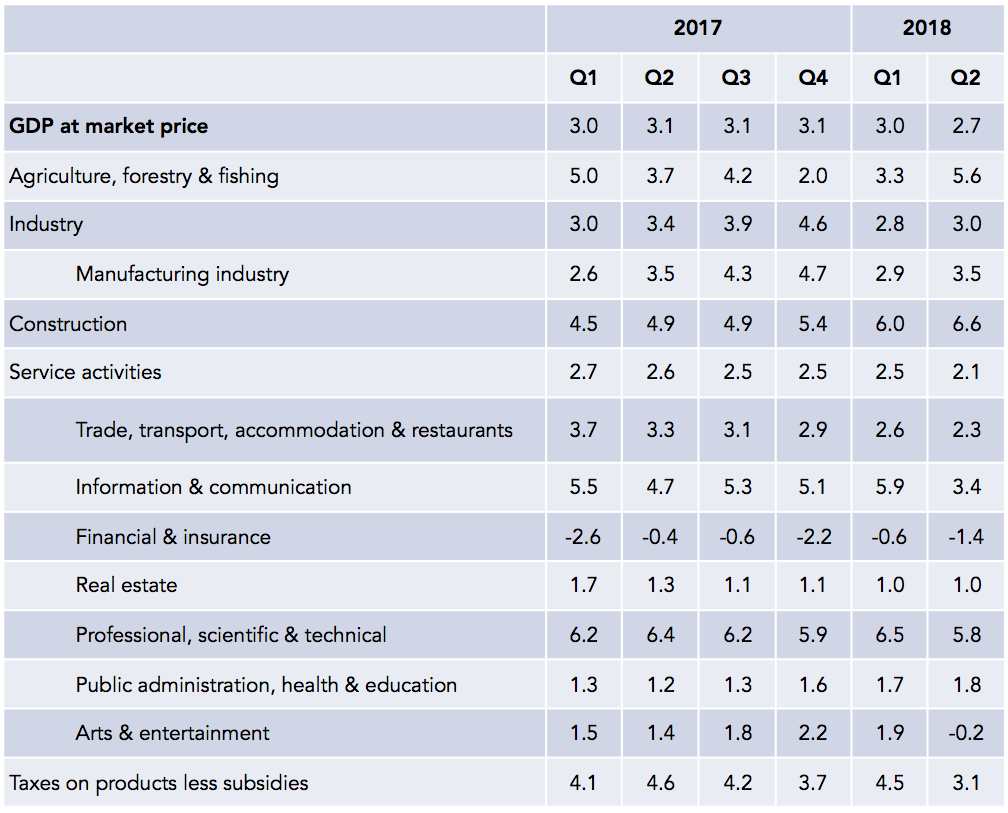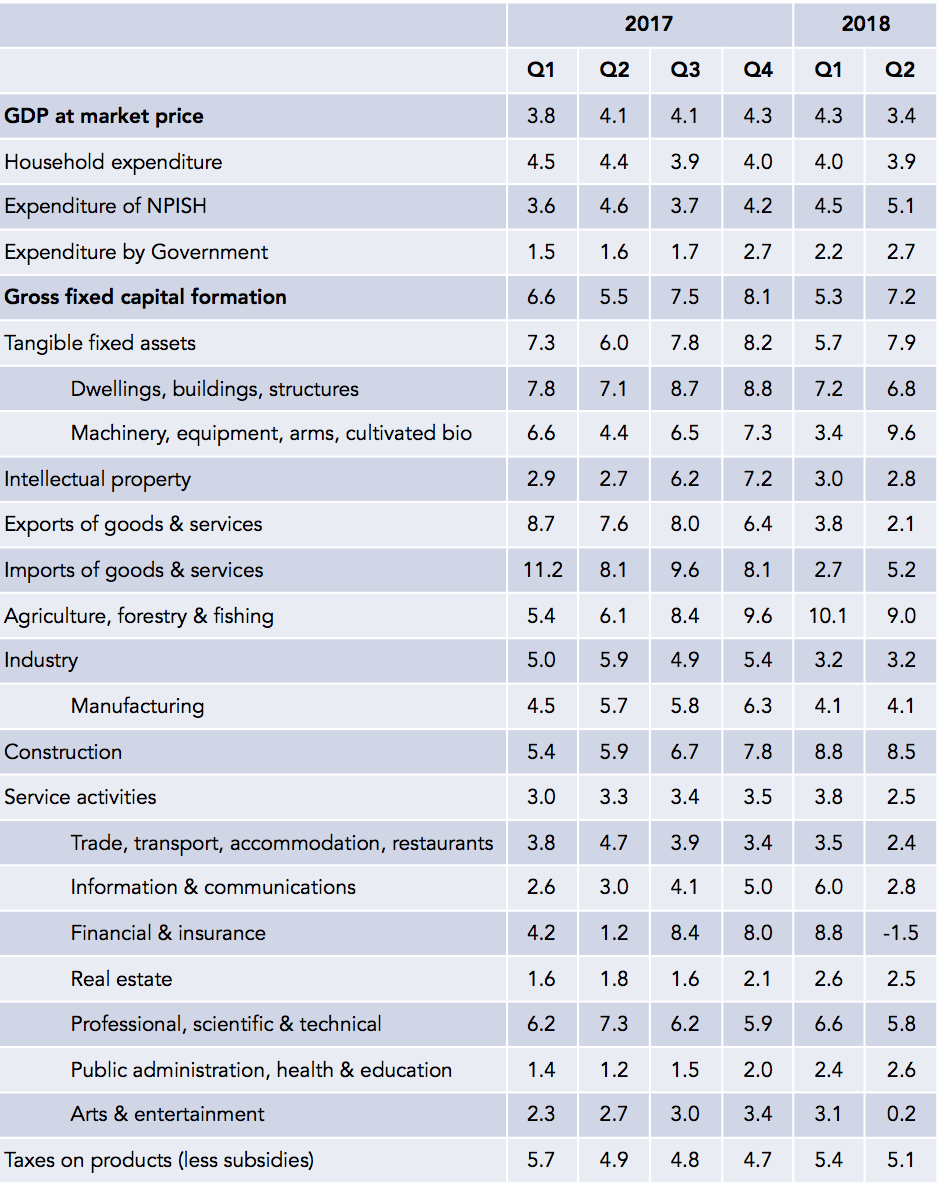GDP in Spain 2nd Quarter 2018

The Spanish Institute of Statistics have published the provisional Gross Domestic Product figures for the second quarter of 2018.
Key Points
The GDP in Spain registered a growth of 0.6% in the second quarter of 2018 compared to the previous quarter in terms of volume.
This rate is one tenth lower than that registered in the first quarter of the year.
The growth compared to the same quarter of the previous year stands at 2.7%, compared to 3.0% in the previous quarter.
The contribution of national demand to the annual growth of GDP is 2.9 points, one tenth higher than in the first quarter.
On the other hand, the external demand presents a contribution of -0.2 points, four tenths lower than that of the last quarter.
The GDP deflator increases 0.7% with respect to the same quarter of the previous year, 6 tenths less than in the previous quarter.
The employment of the economy, in terms of full-time equivalent jobs, registered a variation of 0.8% with respect to the previous quarter, three tenths higher than that registered in the first quarter.
In year-on-year terms, employment increased at a rate of 2.5%, one tenth less than in the first quarter, which represents an increase of 448 thousand full-time equivalent jobs in a year.
The annual variation of the unit labor cost stands at 0.6% this quarter.
Gross Domestic Product
Chain linked quarter on quarter growth rates (%)
 Year-on-year GDP: demand
Year-on-year GDP: demand
The contribution of the national demand to the annual growth of the GDP is 2.9 points, one tenth higher than that of the first quarter.
For its part, foreign demand presented a contribution of -0.2 points, four tenths less than in the previous quarter.
National demand
The final consumption expenditure increased by 2.2% with respect to the same quarter of the previous year, four tenths less than in the first quarter.
The final consumption expenditure of households experienced an annual growth of 2.2%, six tenths less than in the last quarter.
On the other hand, the final consumption expenditure of the Public Administrations shows a year-on-year variation of 2.1%, two tenths higher than that of the previous quarter.
Gross capital formation registered a growth of 5.9%, 2.2 points higher than the previous quarter.
Investment in tangible fixed assets grew at a rate of 6.0%, which is 2.3 points more than in the previous quarter.
As part of the same, investment in housing and other buildings and constructions increased its annual rate one tenth from 4.7% to 4.8%.
Investment in machinery, capital goods and weapons systems shows a growth of 7.9% in the second quarter of 2018, compared to 2.3% in the previous quarter.
Investment in intellectual property products experienced a variation of 3.5%, with an increase of six tenths compared to the previous quarter.
GDP: National Demand
Chain linked year on year growth rates (%)

External demand
Exports of goods and services grew by 1.2% compared to the second quarter of 2017, which is 2.0 points less than in the previous quarter.
This lower growth is due to a decrease in the annual rate of exports of goods (from 1.9% to 1.0%) and exports of services (from 6.2% to 1.6%).
Within these, the expenditure of non-residents in the economic territory decreases 2.6 points (from 5.2% to 2.6%).
Imports of goods and services increased by 2.1% compared to the same quarter of the previous year, seven tenths less than in the first quarter.
This lower growth is due, in part, to a decrease in the annual rate of goods imports (from 2.3% to 0.8%).
However, services imports accelerated their growth rate by 2.6 points (from 5.0% to 7.6%).
Of the latter, spending by residents in the rest of the world decreased 2.6 points year-on-year growth this quarter (from 11.9% to 9.3%).
The gross added value of the industrial branches increased by 3.0% with respect to the same quarter of 2017, which represents an increase of two tenths with respect to annual variation registered in the previous quarter.
Within these, the manufacturing industry presents a rate of 3.5%, six tenths higher than the previous quarter.
The gross added value of Construction grew by 6.6% compared to the same quarter of 2017, six tenths more than in the previous quarter.
The annual variation of the gross added value of the Services in the second quarter is 2.1%, four tenths less than that of the previous quarter.
Finally, primary branches recorded an annual variation of 5.6% this quarter, compared to 3.3% in the previous quarter.
GDP: Supply
Chain linked year on year growth rates (%)

GDP at current prices and implicit deflation
The GDP at current prices grows at a rate of 3.4%. This growth is nine tenths lower than that registered in the first quarter of the year (4.3%).
GDP: Current prices
Chain linked year on year growth (%)

GDP at current prices: salaries
The remuneration of employees shows a year-on-year growth of 4.0% in the second quarter, four tenths higher than the previous quarter.
This result is a consequence of the 3.2% increase in the number of employees, similar to the previous quarter, and that the average remuneration per employee varies by 0.7%, compared to 0.4% in the first quarter.
The gross operating surplus / gross mixed income generated in the economy grew by 2.3% with respect to the same quarter of the previous year, 2.5 points less than in the first quarter.
Finally, the amount accrued in taxes on production and net imports of subsidies grew by 5.1%, compared to 5.4% in the previous quarter.
GDP: Salaries
Current prices year on year growth (%)

Employment
The level of employment, in terms of full-time jobs, increased by 0.8% with respect to the previous quarter, a variation that is three tenths higher than that registered in the first quarter.
In annual terms, employment grew by 2.5%, one tenth less than that recorded in the previous quarter, which represents an increase of 448 thousand full-time jobs in a year.
The employment in industry increased by 2.1%, eight tenths less than in the previous quarter.
In the case of Construction, the annual variation of employment is 7.5%, three tenths more than in the previous quarter.
Employment in Services decreased one tenth year-on-year growth compared to the previous quarter, to 2.3%.
Finally, employment in agriculture, forestry & fishing shows a variation of -0.1%, compared to 0.7% in the previous quarter.
Employment

The number of hours actually worked increased by 1.3% compared to the first quarter, six tenths more than in the previous quarter.
In year-on-year terms, the number of hours actually worked grew 2.7%, seven tenths more than last quarter.
With this, the annual variation of productivity per job equivalent to full time decreases two tenths with respect to the first quarter of the year, from 0.3% to 0.1%, while the productivity per hour actually worked varies by point less than in the previous quarter (0.0%).
Finally, the unit labor cost (CLU) grew by 0.6% compared to the second quarter of 2017, one tenth below the variation experienced by the implicit deflator of the economy (0.7%).
Source: Instituto Nacional de Estadística